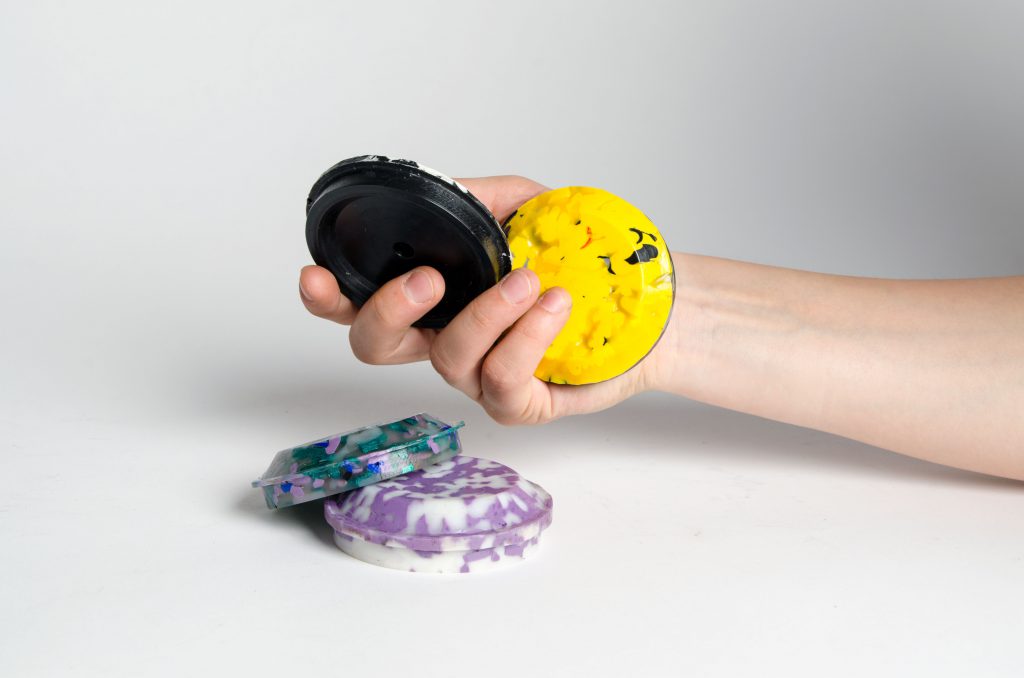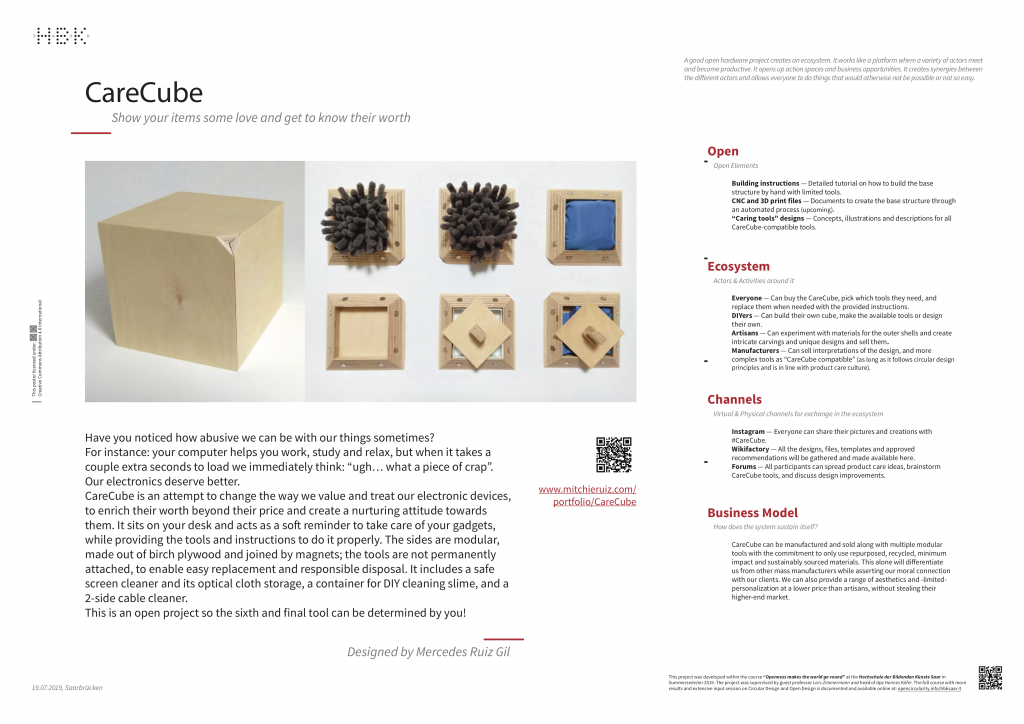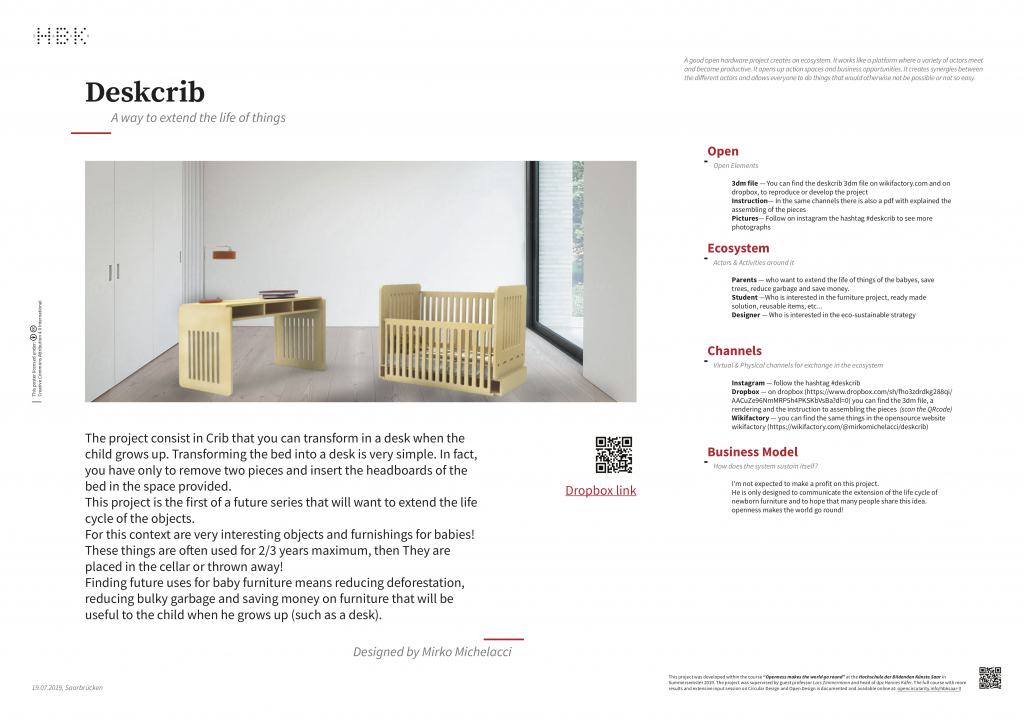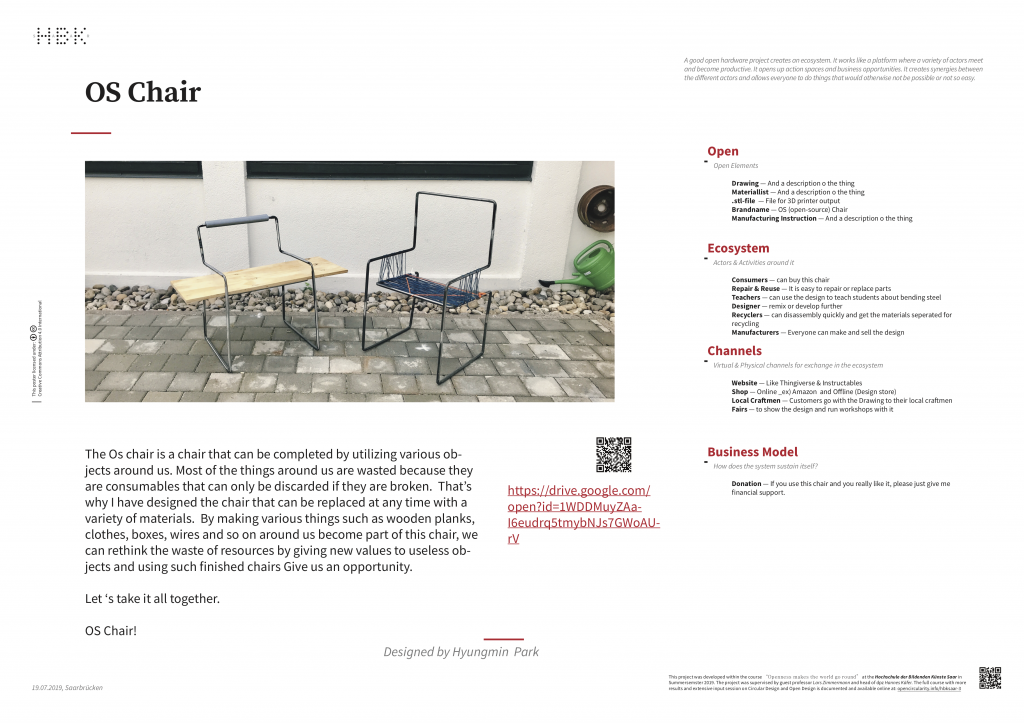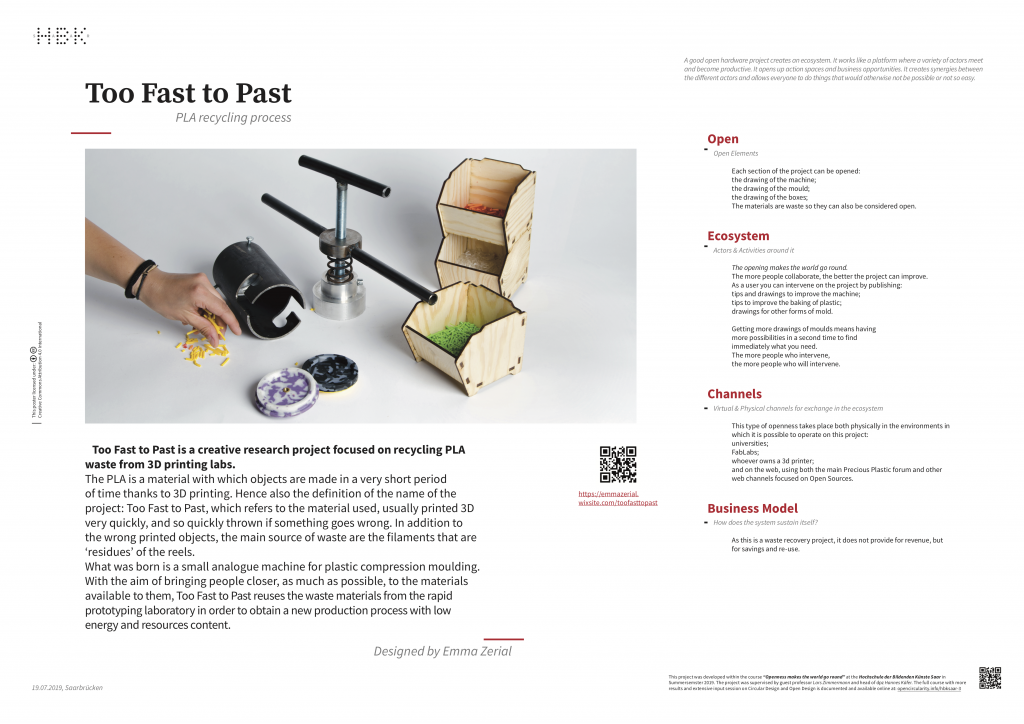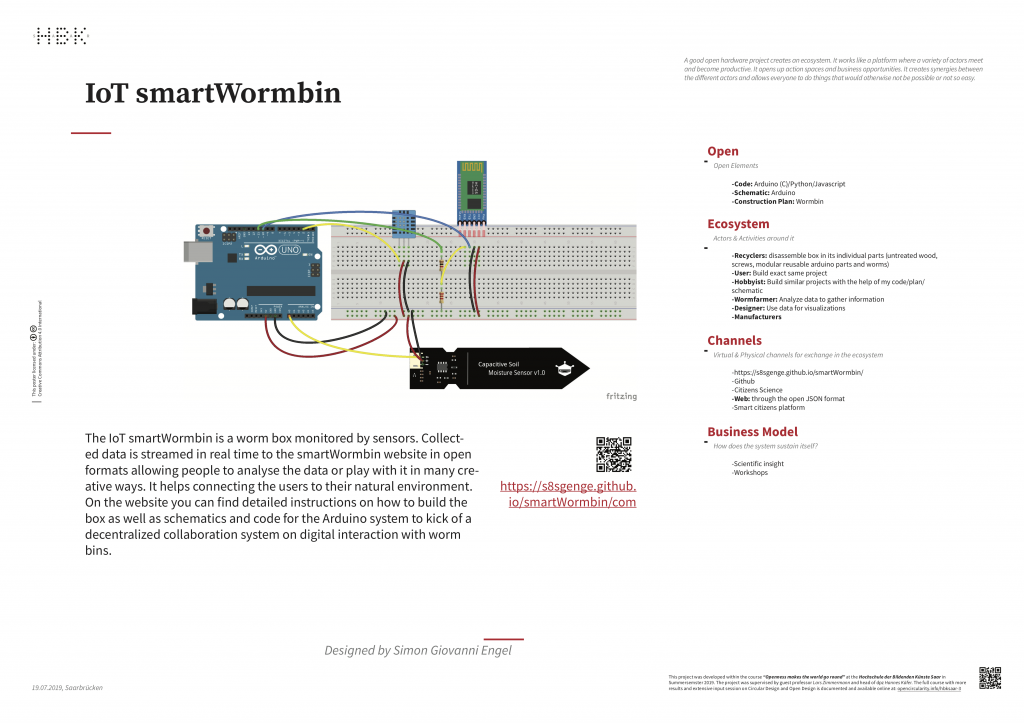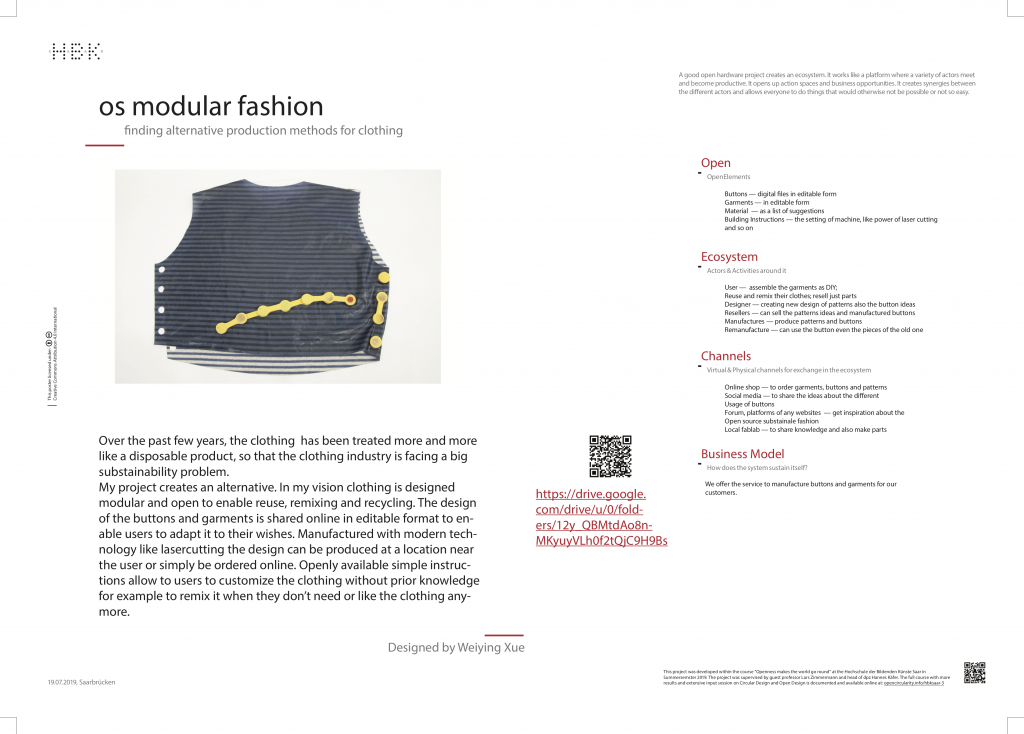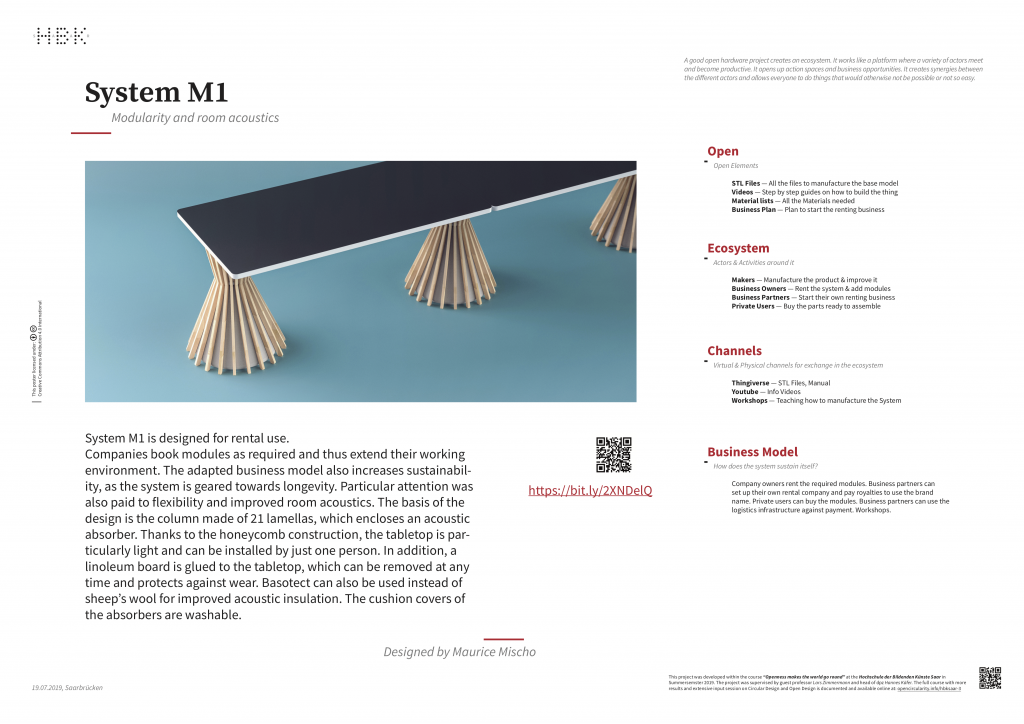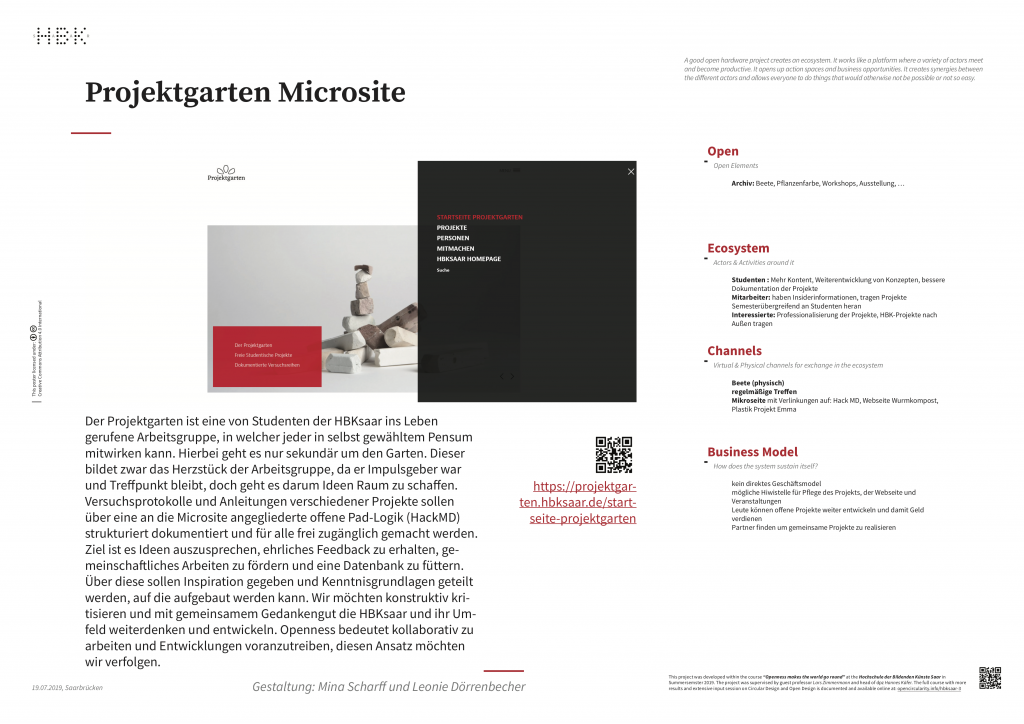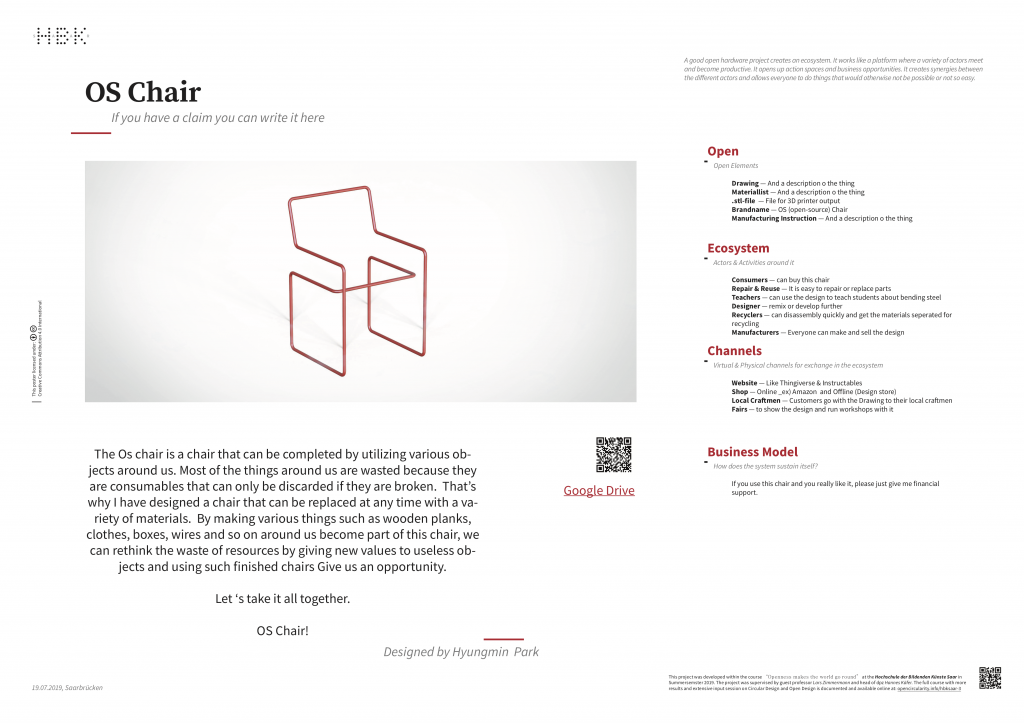Meta
Title: 8 student projects on open circular design
What: Article
Made for: HBKsaar
Deutsch & English ↓
8 studentische Projekte zu Open Circular Design
↦
Im Sommersemester 2019 hat Lars als Gastprofessor für Design an der HBKsaar (Hochschule der Bildenden Künste Saar) gearbeitet. Die Lehrinhalte des Kurses „Openness Makes The World Go Round“ sind vollständig online. Im Atelierprojekt sind insgesamt 8 Studierendenprojekte zu Open Design für die Kreislaufwirtschaft entstanden. Hier sind sie:
←
1 CareCube
Langlebigkeit ist ein Schlüssel für wirklich nachhaltiges Design. In einer Wegwerfgesellschaft ist die Kultur der Pflege und Wartung von Alltagsprodukten etwas rückentwickelt. Der CareCube stellt Lösungen bereit, mit denen wir unsere elektronischen Geräte sauber, schön und fit halten. Jede Seite des Cubes bringt eine andere Pflegelösung für einen anderen Teil eines Gerätes mit. Der Cube ist open und modular. So können verschiedene Pflegelösungen eingesetzt und hinzugefügt werden. Der Cube ist demnach eine offene Platform für Pflegelösungen.
2 Deskcrib
Deskcrib ist ein Bett für Kleinkinder, welches sich später in einen Schreibtisch für größere Kinder umbauen lässt; das Möbel wächst und verändert sich mit den kognitiven Entwicklungsschritten eines Kindes. Das System ist insofern offen, dass es einen Anfang bildet: Durch offene Dokumentation und Lizenzierung können andere Designer*innen weitere Umnutzungsmöglichkeiten hinzufügen für weitere Entwicklungsstufen des Kindes. Steigende ReUsability durch Openness.
*
3 OS Chair
Der OS Chair ist eine Rohrkonstruktion für einen Stuhl, die es erlaubt, verschiedene wechselnde Einlagen für Sitz- und Lehnflächen zu nutzen. Er unterstützt damit das Re-Use (oder auch Upcycling) von Plattenmaterial. Daneben ist der Stuhl selbst re-useable z.B. als Regalgerüst an einer Wand. Zudem besteht das Gestell aus einem Monomaterial (Edelstahl) und ist damit selbst schnell und einfach zu recyceln.
Poster als PDF | Bild 1 | Bild 2 | Video
4 To Fast To Past
To Fast To Past ist ein sehr einfach zu bauendes und leicht zu benutzendes Tool/Werkzeug, um PLA-Reste z.B. aus dem 3D-Druck selbst zu recyceln. Alles was man braucht, ist das Tool, eine Form und einen normalen Heimbackofen. Das Projekt schafft es, die bereits sehr einfachen DIY-Plastik-Recycling-Maschinen des Precious-Plastic-Projektes nochmal weiter zu vereinfachen und das Plastikrecycling für uns alle greifbarer zu machen! Sehr cool!
Das Projekt hat auch eine Webseite. Und wir haben auch ein paar mehr Bilder davon unterm Posterbild:
Poster als PDF | Bild 1 | Bild 2 | Bild 3 | Webseite
5 IoT Smart Wormbin
Diese Wurmkiste ist mit Sensoren ausgestattet. Sie sendet Echtzeitdaten über Gewicht, Feuchtigkeit und Temparatur aus der Wurmkiste live ins Netz als offenen Datenstrom. So kann die Welt teilnehmen an den Geschehnissen in der Box und z.B. Datenvisualisierungen beisteuern (Wird den Würmern beispielsweise zu heiß, schreien sie, oder schreiben eine SMS usw.)
Das System fügt eine interaktive Schicht zu einer Standardwurmkiste hinzu und macht damit Heimkompostierung interessanter. Digitale Medien öffnen einen Kanal zur Biosphäre um uns herum. Offene Wurmkisten können zudem weltweit über Smart Citizen-Platformen vernetzt werden und voneinander lernen um sich z.B. gegenseitig warnen bei kritischen Temparatur- oder Gewichtsverläufen.
Poster als PDF | Webseite des Projektes
6 OS Modular Fashion
Kann man mit offener Modularität gegen unsere wachsenden Textilmüllberge angehen? Dieses Projekt entwickelt ein flexibles Knopfsystem, mit dem sich modulare Einzelteile zu Kleidungsstücken zusammenknüpfen lassen. So kann man beispielsweise kaputte Ärmel schnell austauschen oder sich jeden Tag eine andere Jacke zusammenknöpfen. Einzelteile können über Second-Hand-Märkte weitergegeben werden.
Das modulare Design erlaubt es außerdem Beschläge und Stoffe schnell voneinander zu trennen für ein sortenreines Recycling.
Poster als PDF | Mehr Bilder | Smartphonebild 1 | Smartphonebild 2 | Video
7 System M1
System M1 ist ein Büromöbelsystem zum Leasen. In einer flexiblen Wirtschaft mit schnell wachsenden und schrumpfenden Unternehmen werden Büromöbel vielleicht lieber geleast als gekauft. Das erhöht den ReUse-Faktor der Möbel. System M1 ist modular aufgebaut und so leicht zu verschiedenen Raumlösungen aufzubauen und auch leicht zu reparieren. Unter den Kegeln finden sich schallabsorbierende Schaumstoffkissen. So wird es leiser und eventuell produktiver im Großraumbüro.
Poster als PDF | Smartphonebild 1
8 Projektgarten Microsite
Im Designstudium lernt man vor allem auch von seinen Mitstudierenden! Im Kolloquium sieht man, welche Probleme sie finden und lösen, welche Materialien, Fertigungs- und Konstruktionstechniken machen sie ausfindig usw. Jedoch ist man bei diesem Lernen immer auf seinen kleinen Projektkreis beschränkt. Hat man Glück mit den Leuten um einen herum, lernt man mehr.
Das Projekt „Projektgarten-Microsite“ will das etwas aufbrechen. Die Projektgarten-Microsite lädet alle Studierenden ein, ihre Projekte auf der offiziellen Internetseite der Hochschule zu veröffentlichen mit beliebig tiefer Dokumentation (mit einer Einführung in Ether-Pads). So wird durch Openness das Lernen zwischen den Studierenden verbessert. Außerdem wird es unter Umständen auch leichter, Ressourcen in Form von Restmaterialien, Erfahrungen oder Kontakten – kurzgesagt Synergien zwischen den Studierenden – zu finden.
Dem Projekt ist es gelungen, diese Seite nicht nur zu konzipieren, sondern tatsächlich auch ins Web zu bringen unter der offiziellen Hochschuldomain abgesegnet von allen offiziellen Stellen! Wir drücken die Daumen, dass das Angebot auch angenommen wird!
–
FAZIT: Das Feedback der Studierenden auf den Kurs war sehr gut. Die Ergebnisse zeigen: Openness im Design widerspricht sehr vielem, was in der Disziplin und Ausbildung sonst in der Hauptsache gelehrt und kulturell ins Zentrum gerückt wird. Nicht allen Projekten gelingt es, sich weit weg vom sonstigen Mainstream zu bewegen und vollständig in ein Ökosystemdenken hinüberzuwechseln. Aber mindestens den halben Weg ist jede*r gegangen, die meisten sogar viel weiter.
Wir selbst haben viel gelernt für unsere zukünftige Lehre; es sind jede Menge neue Ideen und Ansätze entstanden, wie an Studierende in zukünftigen Projekten Openness herangetragen werden kann. Eine Produktentwicklung ist ein komplexer Prozess. Parallel auch noch einen großen Strauß neuer Ideen und Fragestellungen mitzudenken, kann schnell überfordern. Eine mögliche Lösung für das Problem könnte sein, in diesem Semester ein Projekt aus einem früheren Semester wieder aufzugreifen und es diesmal als offenes Produkt für ein offenes Ökossystem umzudenken. Alternativ könnte man auch einen Designklassiker dafür nehmen. Auch wäre es überlegenswert, ein konkreteres Thema zu setzen, Ideen dafür gibt es viele.(Bild entstanden als Teil hiervon.)
Hopefully to be continued!
VIELEN DANK! an Hannes Käfer für die tolle Unterstützung im Projekt (you rock!) und an Prof. Mark Braun für die Vertretungseinladung und Beratung.
Die vollständigen Kursinhalte stehen hier– denn: Openness Makes The World Go Round!
*
English Version
8 student projects on Open Circular Design from our guest professorship at HBKsaar this summer.
In the summer semester 2019 Lars worked as guest professor for design at the HBKsaar (Universit Hochschule der Bildenden Künste Saar). The entire content of the atelier project “Openness Makes The World Go Round” is online. Altogether 8 student projects on Open Design for Circularity were created. Here they are:
.
1 CareCube
Durability is a major key to sustainable design. We need a stronger culture of care and maintenance. The CareCube provides solutions to keep our electronic devices clean, beautiful and fit. Each side of the Cube brings a different care solution for a different part of a device. The Cube is open and modular. So different care solutions can be added by everyone. With this CareCube works as an open platform for care solutions.
.
2 Deskcrip
Deskcrib is a bed for toddlers that can later be converted into a desk for older children; the furniture grows and changes with a child’s cognitive development and size. The system is open in the sense that it is a beginning. Through open documentation and licensing other designers* can add further conversions and enhancements for later stages. ReUsability can grow through openness.
.
3 OS Chair
The OS Chair is a tubular construction for a chair that allows the use of various alternating inserts for seat and backrests. It thus supports the re-use (or upcycling) of panel material. In addition the chair itself is re-useable, e.g. as a shelf frame on a wall. The frame can be made from a mono material (stainless steel) and is therefore quick and easy to recycle.
Poster as PDF | Pic 1 | Pic 2 | Video
4 To Fast To Past
To Fast To Past is a very easy to build and also easy to use tool to recycle plastic residues e.g. from 3D printing (PLA). All you need is a mold and a standard oven. The project manages to further simplify the already very simple DIY plastic recycling machines of the Precious Plastic project and to make plastic recycling more tangible for all of us! Very cool!
The project also has a website. And we also have some more pictures of it under the poster picture:
Poster as PDF | Pic 1 | Pic 2 | Pic 3 | Webseite
5 IoT Smart Wormbin
This worm bin is equipped with sensors. It transmits real-time data on weight, humidity and temperature from the worm box live into the internet as an open data stream. So the world can take part in the events in the box and e.g. contribute data visualizations (If the worms get too hot, they scream, or write an SMS etc.).
With this the system adds an interactive layer to a standard worms box, making home composting more interesting and connecting people to circular processes around them. Digital media opens a channel to the biosphere around us. Open worm bins can also be networked worldwide via Smart Citizen platforms and learn from each other to warn each other for example when critical temperature or weight progressions occur.
Poster as PDF | Project Website
6 OS Modular Fashion
Is it possible to tackle the still growing fast fashion culture with open modularity? This project is developing a flexible button system that allows modular textile components to be linked together to form garments. For example broken sleeves can be quickly replaced or a different jacket can be knotted together every day. Individual parts can be passed on via second-hand markets.
The modular design also allows fittings and fabrics to be quickly separated from each other for recycling.
Poster as PDF | More Pics | Smartphone pic 1 | Smartphone pic 2 | Video
7 System M1
System M1 is an office furniture system for leasing. In a fast paced economy with rapidly growing and shrinking businesses office furniture may be leased rather than purchased. This increases the ReUse factor of the furniture. System M1 is modular and thus easy to assemble for various space solutions and also easy to repair. Sound absorbing foam cushions can be found under the cones. This makes it quieter and possibly more productive in an open-plan office.
Poster as PDF | Smartphone pic 1
8 Projektgarten Microsite
In design studies you learn above all from your fellow students! In the colloquium you can see which problems they find and solve, which materials, production and construction techniques they are around and how to deal with them? However this learning is always limited to the small project group in your semesters. If you are lucky with the people around you you will learn more
The project “Projektgarten-Microsite” wants to break this up a bit. The Projektgarten-Microsite invites all students to publish their projects on the official website of the university with extended documentation of any depth (with an introduction to ether pads). Openness improves learning between students. In addition, it may also be easier to find resources in the form of experiences, contacts or residual materials – in short, to find synergies between the students through open online documentation.
The project not only managed to design this site, but also to bring it to the web under the official university domain, approved by all official bodies! We keep our fingers crossed that the offer will also be accepted by the students and find its place in the culture of the university!
–
CONCLUSION: The students’ feedback on the course was very good. The results show: Openness in design contradicts a lot of what is established in the disciplines mainstream. Not all projects succeed in moving far away from that mainstream and switching completely to open ecosystem thinking. But everyone has gone at least half the way, some even much further. Thank you for that!
I as the teacher in this course learned a lot for our future teaching; a lot of new ideas and approaches have emerged on how to bring Openness to students. Product development is a complex process. To think along with a large bunch of new ideas and questions at the same time can quickly become overtaxing. A possible solution to this problem could be to pick up a project from an earlier semester and rethink it this time as an open product for an open ecosystem. Alternatively, you could use a design classic. It would also be worth considering to set a more concrete topic, there are many ideas for it. (Picture developed as part of this.)
Hopefully to be continued!
.
MUCH THANKS! to Hannes Käfer for the great support in the project (you rock!) and to Prof. Mark Braun for the representation invitation and consultation.
The complete course contents are HERE – because: Openness Makes The World Go Round!
English Version translated with www.DeepL.com/Translator
–
IMAGE CREDITS: All posters are licensed CC-BY (as you can see on the left side of them), the authors are on the poster. The lead images of this post are taken by Emma Zerial and used with permission.
